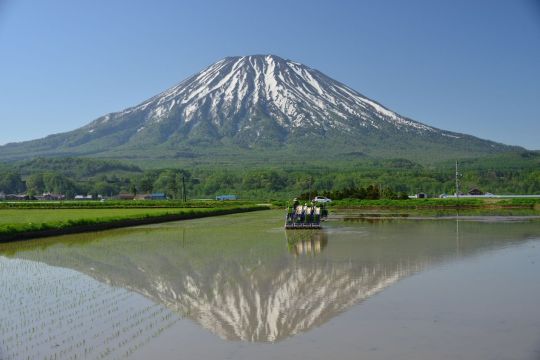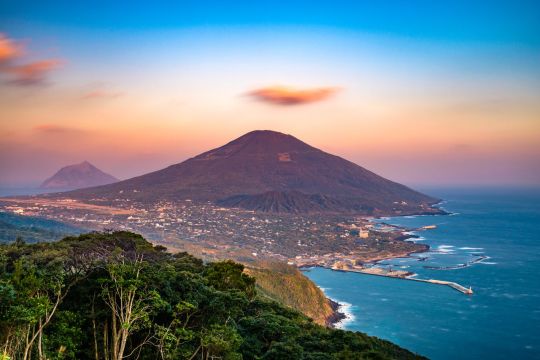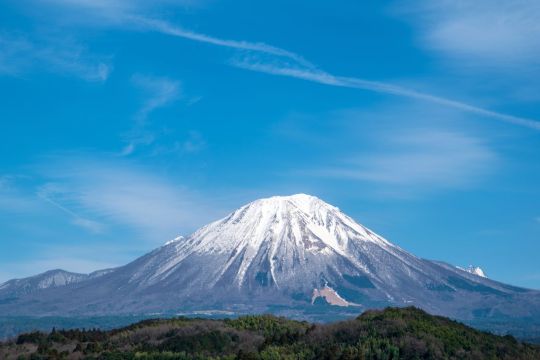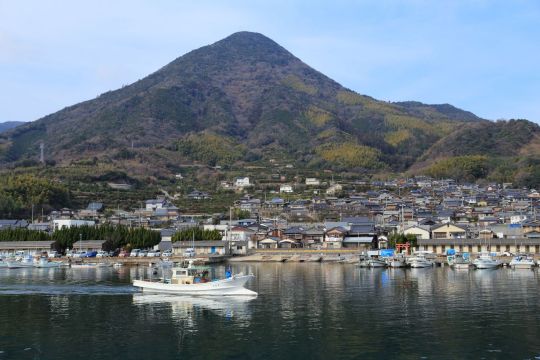#Rishiri fuji
Explore tagged Tumblr posts
Text

Rishiri-fuji
1 note
·
View note
Text
Passengers transferring between FDA and HAC can get a collaboration flight tag. Rishiri route passengers will also be entered into a drawing for goods and Rishiri/Rebun specialties.
Fuji Dream Airlines (FDA) and Hokkaido Air System will hold the “Sapporo (Okadama) Airport Transit Campaign” from July 27 to October 26. During the period, the first 300 passengers who make a connection at Sapporo Okadama Airport between the two companies’ flights within three days will receive a flight tag key chain. The first 300 passengers will receive a flight tag key chain by presenting…
0 notes
Photo








Japan abounds in conical mountains dubbed something-something Fuji for their resemblance to the iconic peak.
You be the judge.
1. Mount Rishiri (Rishiri Fuji), Hokkaidō
2. Mount Yōtei (Ezo Fuji), Hokkaidō
3.Mount Iwaki (Tsugaru Fuji), Aomori
4. Mount Iwate (Nanbu Fuji), Iwate
5. Mount Chōkai (Dewa Fuji), Akita and Yamagata
6. Nishiyama (Hachijō Fuji), Izu Islands
7. Mount Daisen (Hōki Fuji), Tottori
8. Mount Himuro (Suō Fuji), Yamaguchi
A Fuji for Every Part of Japan
37 notes
·
View notes
Text
Martian stratovolcanoes Zephyria Tholus and Elysium Mons
While stratovolcanoes are common on Earth, they’re extremely rare on other planets of solar system.
on Mars, almost all volcanoes are shield, except few cinder cones and two stratovolcanoes (of those, one is also a shield). on Venus there are no stratovolcanoes at all, but there are pancakes domes, that can’t be found on Earth and Mars. It should be noted, however, that Venus has an atmospheric pressure that is 90 times the one of Earth, so possibly stratovolcanoes might have been squished from the start, developing into shield instead.
The only pure stratovolcano on Mars is named Zephyria Tholus.

https://onehundredmountains.blogspot.com/2011/05/meizan-from-outer-space.html
Meizan from outer spaceA new candidate for the “Mt Fuji of Mars” is proposed. And why stop there… ? Sumimasen: a few posts ago, I did something ill-considered. It was reckless to designate Mons Olympus, the largest volcano on the Red Planet, as "the Mt Fuji of Mars" (火星富士). For even the briefest glance shows that the Martian mountain (below) looks nothing like Mt Fuji. It isn’t even the same kind of volcano.
And, if you do seek a Mars-Fuji, there are better choices. Take Zephyria Tholus, for instance, an “unusually symmetrical cone located in the Aeolis region of Mars … with a flat-floored summit crater”. As you’d expect from this description, Zephyria is likely to be a stratovolcano. That is certainly the conclusion of Emily Lewis and James Head, two savants from Brown University who analysed the radar data from NASA’s Mars Orbiter.
Just like the real Mt Fuji, the Martian cone (above) has slightly concave upper slopes and its edifice is “dissected” by two huge erosion gullies. Even the height is Fuji-like: about 3,000 metres today and perhaps as tall as 3,900 metres in the past. Like Fuji’s, the summit crater plunges about 200 metres deep. However – and this is where the comparison does get a bit stretched – Zephyria’s cauldron is about eight or nine times wider than the Japanese one. Also, its summit slopes are only about half as steep as Fuji’s. All in all, Zephyria would look squatter than Fuji. That, say Lewis and Head, is only to be expected of Martian volcanoes – the low gravity and thin atmosphere allow eruptive debris to fly further, resulting in a more spread-out edifice. You see, Mars is a foreign planet; they do things differently there.
Yet proposing Zephyria as Mars-Fuji shouldn’t be too controversial. It only extends the Japanese custom of awarding the “Fuji” suffix to any mountain that looks remotely conical. Thus, there is hardly a Japanese prefecture without its own Fuji, from one end of the archipelago to the other: Rishiri-Fuji, Ezo-Fuji, Tsugaru-Fuji … The point about all these honorary Mt Fujis is that they share the elegance of their original. In short they are “Meizan”. The word is Japanese, but it can apply to any mountain of note, anywhere. When they relabelled Mt Rainier (below) as “Tacoma-Fuji”, homesick émigrés from Japan implicitly recognised that.
So did Fukada Kyūya, the maven of Meizan. Encouraged by the success of his One Hundred Mountains in Japan (Nihon Hyakumeizan), he was busy compiling a Sekai no Hyakumeizan (One Hundred Mountains of the World) when he died in 1971. But why stop with the world? As Lewis and Head show, other planets have Meizan too. Indeed, there should be more than enough for a One Hundred Mountains of the Solar System (太陽系の百名山). Now which would they be, I wonder.... ?
The other stratovolcano (though is an half shield), Elysium Mons, might have characteristics similar to Mount Etna, a large shield base with a tiny stratocone on the top (though Etna has FOUR tiny stratocone on the top of a still active large shield)

From wikipedia: https://repress.alummah.news/browses.php?q=https%253A%252F%252Fen.wikipedia.org%252Fwiki%252FVolcanology_of_Mars
Elysium volcanic province
A smaller volcanic center lies several thousand kilometers west of Tharsis in Elysium. The Elysium volcanic complex is about 2,000 kilometers in diameter and consists of three main volcanoes, Elysium Mons, Hecates Tholus, and Albor Tholus. The northwestern edge of the province is characterized by large channels (Granicus and Tinjar Valles) that emerge from several grabens on the flanks of Elysium Mons. The grabens may have formed from subsurface dikes. The dikes may have fractured the cryosphere, releasing large volumes of ground water to form the channels. Associated with the channels are widespread sedimentary deposits that may have formed from mudflows or lahars.[37] The Elysium group of volcanoes is thought to be somewhat different from the Tharsis Montes, in that development of the former involved both lavas and pyroclastics.[38]
Elysium Mons is the largest volcanic edifice in the province. It is 375 km across (depending on how one defines the base) and 14 km high. It has single, simple caldera at its summit that measures 14 km wide and 100 m deep. The volcano is distinctly conical in profile, leading some to call it a stratocone;[39] however, given the predominantly low slopes, it is probably a shield. Elysium Mons is only about one-fifth the volume of Arsia Mons.[37]
Hecates Tholus is 180 km across and 4.8 km high. The slopes of the volcano are heavily dissected with channels, suggesting that the volcano is composed of easily erodible material such as volcanic ash. The origin of the channels is unknown; they have been atrributed to lava, ash flows, or even water from snow or rainfall.[40] Albor Tholus, the southernmost of the Elysium volcanoes, is 150 km in diameter and 4.1 km high. Its slopes are smoother and less heavily cratered than the slopes of the other Elysium volcanoes.[41]
1 note
·
View note
Text
Bên trong tiệm mì soba phục vụ hoàng gia Nhật Bản
Cẩm nang du lịch DU LỊCH THẾ GIỚI Châu Á Bên trong tiệm mì soba phục vụ hoàng gia Nhật Bản
Honke Owariya khởi nghiệp là cửa hàng bánh kẹo nhỏ nhưng nổi tiếng nhờ mì soba và còn phục vụ cho hoàng gia Nhật qua nhiều thế kỷ.
Du lịch Nhật Bản thưởng thức mì soba ở Honke Owariya, tiệm mì với lịch sử hơn 550 năm
Honke Owariya với lịch sử hơn 550 năm nổi tiếng là quán mì soba ngon nhất, lâu đời nhất Kyoto. Quán nằm trong tòa nhà gỗ cũ, phía nam lâu đài Hoàng gia. Đây là quán ăn phục vụ cho gia đình hoàng tộc, tướng lĩnh cũng như thầy tu trong các chùa ở cố đô qua nhiều thế kỷ. Ngoài mỳ, quán cũng được biết tới với nhiều loại bánh kẹo. Ảnh: Wally Gobetz.
Honke Owariya mở cửa từ năm 1465 với mục đích ban đầu là cửa hàng bánh kẹo, nhưng về sau mì soba mới là món ăn làm nên danh tiếng của quán. Theo Deep Kyoto, quán đã làm mì cách đây 300 – 400 năm. Những thực khách thích đồ ngọt cũng không phải thất vọng vì quán vẫn còn bán bánh kẹo ở quầy trước cửa. Ảnh: Bonson Lam.
Rong biển xắt nhỏ, củ cải, hành, trứng, tempura tôm, nấm hương… là những thứ không thể thiếu khi ăn mì. Tùy theo mùa mà nhà hàng còn có thêm như tempura măng. Nước dùng chính là “linh hồn” của tô mì soba tại Honke Owariya. Theo lời chủ quán đời thứ 15, Inaoka: “Thời gian lý tưởng nhất để ăn mì soba là vào mùa thu, ngay sau mùa thu hoạch kiều mạch”. Năm 2014, Inaoka Ariko là con gái Inaoka và trở thành chủ quán thứ 16. Ảnh: Wally Gobetz.
Mì soba được làm từ bột kiều mạch và bột mì. Món này có thể ăn cả nóng hoặc lạnh tùy vào mùa. Japan Travel từng viết, nhà hàng sử dụng nguồn nước suối “mát lành nhất” của Kyoto để làm nên nước dùng thơm ngon. Quán dùng bột kiều mạch từ Hokkaido, dùng tảo bẹ rishiri để gia giảm hương vị cho nước dùng dashi và tuyệt nhiên không dùng thêm gì khác. Ảnh: shuuji_shirasu.
Bước vào quán, du khách sẽ thấy một khu vườn nhỏ rồi đến các phòng ăn zashiki (phòng trải sàn bằng chiếu tatami) và tokonoma (chỗ ngồi ở góc phòng treo tranh và lọ hoa). Khách đến ăn trong một nhà hàng truyền thống Nhật Bản sẽ phải ngồi bệt trên đệm và chiếu tatami. Quán đã mở thêm 2 nơi khác với bày trí hiện đại hơn nên khách lớn tuổi hay đau đầu gối có thể chọn nơi có bàn ghế. Quán chính mở cửa từ 11h tới 19h hàng ngày, đóng cửa ngày 1 và 2/1. Ảnh: Chee Sheng Ng.
IVIVU.COM GỢI Ý MỘT SỐ KHÁCH SẠN TOKYO GIÁ TỐT
1. Smile Hotel Asakusa
2. Hotel MyStays Asakusa
3. Hotel New Star Ikebukuro
IVIVU.COM GỢI Ý MỘT SỐ TOUR DU LỊCH NHẬT BẢN GIÁ TỐT
1. Tour Nhật Bản 4N3D: Mùa Hoa Anh Đào
2. Tour Nhật Bản 4N3Đ: Narita – Tokyo – Yamanashi
3. Tour Nhật Bản 6N5Đ: Tokyo – Hakone – Fuji – Osaka
Theo Hương Chi/Vnexpress
Xem thêm các bài viết:
Bên trong khách sạn sex bỏ hoang nổi tiếng nhất Nhật Bản
Chùm tour Nhật Bản giảm giá sốc, thủ tục visa đơn giản tại iVIVU.com
10 điều đặc biệt và mới mẻ chờ đón du khách ở Kyoto
***
Tham khảo: Cẩm nang du lịch iVIVU.com
iVIVU.com June 9, 2017
Đánh giá bài viết này
(1 votes, average: 5.00 out of 5) Loading…
Xem khuyến mãi Global Resources
0 notes
Photo

Rishiri Fuji under clouds.
2 notes
·
View notes